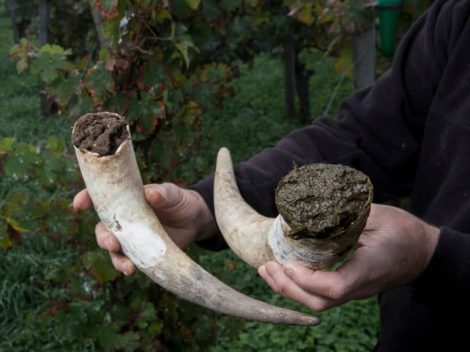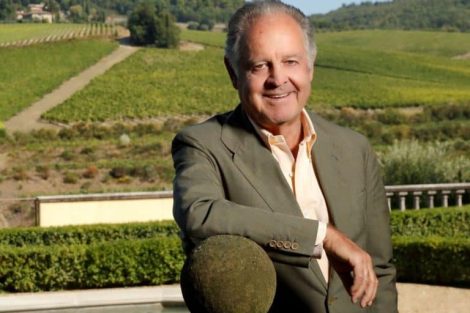Only by visiting the state of Oaxaca and treading the lands where the imposing agave plants grow can one fully grasp the sacred significance associated with Mezcal. It is currently the most fashionable spirit, appreciated for its sensory qualities, although its origins and history are often overlooked. It is something that is definitely worth discovering.
Let's start by giving it a temporal and spatial connotation. Mezcal (pronounced with a delicate "s" instead of "z") has ancient and mythical origins. The practice of distillation was widespread in Mexico even before the Spanish conquest of 1521: archaeological findings in caves between the Yagul and Mitla sites testify that agave cultivation dates back approximately 10,000 years. There was—and still is—the goddess Mayatl, the "agave woman," who nourished her people with 40,000 breasts from which Mezcal flowed. This is the first reason why Mezcal can be considered a mystical and magical beverage.
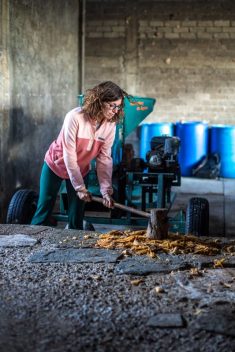
A woman works in a distillery in Bramaderos. At the beginning, there is a landscape with agave.
From "pulque" to success
In the past, pulque, fermented agave juice that became alcoholic, was consumed, and even today, it is sold in the typical containers made from dried jicara shells (a local type of gourd) in the colorful markets of the country.
Before the arrival of the conquistadors, there was a beverage more akin to an agave "wine": the Aztecs let the agave pineapple ferment after cooking it, resulting in a drink that alleviated pains and sorrows. In Aztec culture, during drinking sessions, the first to get drunk hosted the spirit of the goddess Mayatl. This beverage appealed so much to the Spaniards that they improved it by bringing stills to South America and began distilling pulque, eventually giving rise to Mezcal about 400 years ago.
Today, Mezcal is a successful spirit, with its most important brands available almost worldwide (such as Los Danzantes, Alipús, Los Siete Misterios), yet it often manages to maintain a decidedly artisanal and even ancestral identity in production methods, especially among smaller and less-known producers within national borders.

Work in the field in San Pedro Taviche. All photos are by Pablo Mekler.
From Oaxaca to Durango
To understand all this, you need to read, but you also have to go to the state of Oaxaca to absorb its complete and fulfilling essence. Our journey begins from its namesake capital, a bustling city of over a million inhabitants where everything is inevitably about Mezcal. It is situated a couple of hours away from various valleys where magic takes shape. In this southern portion of Mexico, we explored some of the most interesting artisanal producers despite the fact that there are nine states where agave distillate production is allowed: the most famous is Oaxaca, followed by Guerrero, Puebla, Michoacán, Guanajuato, San Luis Potosí, Zacatecas, Durango, Tamaulipas (even though the origins of Mezcal production can be traced to Jalisco and Tlaxcala).

But what is Mezcal?
It is the Mexican spirit obtained from the fermentation and distillation of agave juice cultivated within the states authorized by law. What characterizes it—and distinguishes it from tequila, produced in a much more restricted territory (Jalisco) and with a single agave variety called Tequilana Weber Azul—is both agriculture and production that is entirely unique to each palenquero (Mezcal producer). After years (at least 6-8 for the earliest and most widespread espadin), agave plants are ready to give their hearts, the pineapple, which is then transported to palenques (distilleries) to be placed in traditional conical earth ovens (measuring more than 3 meters in diameter and about 2.5 meters deep, tiled with stones that preheat 24 hours before precisely placing the split pineapples). They are "cooked" for two to three days using encino wood, all perfectly covered to create an oxygen-free container. Each palenquero, with their unique knowledge and practices, extracts the pineapples from the ovens and lets them rest in the open air for a week. The largest ones, which were inserted whole and placed at the base, are then broken into several parts, and the milling process begins, initiating a spontaneous fermentation. The pineapples are crushed in a stone mill, driven by a donkey or horse, known as the "ruota cilena." The pulp, juice, and fibers are mixed with water in pine wood tanks (the best is sabino wood, although it is almost no longer available), initiating a second natural fermentation that can last from one to four weeks. From here, the process moves on to distillation, generally carried out in copper stills where the mash is inserted with some fibrous agave residues—a crucial feature that characterizes Mezcal. At the end of the first distillation, the still is emptied of its contents before, if desired, a second distillation is performed.
Many distillers, many recipes
In any case, each palenquero has their own recipe and techniques, often passed down from fathers and grandfathers, generations that precede this still intact present and seem to be carved in time. Distillations are a romantic moment, at least in artisanal distilleries always adjacent to the homes of palenqueros, with flames from wood-fired stoves, vapors, rising temperatures (the climate is cool in the morning and evening as these valleys can reach up to 2000 meters), notes of traditional Mexican music, and a bottle of Mezcal that is never absent. The liquid obtained is then stored in stainless steel containers and plastic barrels or, alternatively, for those opting for aging, in wooden vats, resulting in reposado (aged for 2 to 11 months in oak barrels) or añejo (at least 12 months) varieties. Purists, however, consider only blanco, the clear Mezcal directly from the still, as true Mezcal. A rare and certainly curious type is pechuga, an ancient Mezcal variant produced for special occasions, where fruits like apples or plums are added to the still, and a chicken breast is hung in the center of the still. It is the rarest version of Mezcal, produced in very limited batches for special occasions like weddings. This is another example of how the world of Mezcal encompasses stories, anecdotes, knowledge, uniqueness, and intangible heritage, in contrast to the infamous worm that used to be placed inside some bottles and has no real significance.

The territory and distilleries
Regarding the territory: excluding the state of Jalisco, intensive agave cultivation is not possible, which further makes Mezcal unique and sacred (it represents only 3% compared to tequila production, which, however, has lost its artisanal character). The topography of the region consists of mountains, hills, steep ridges, poor soils, and rugged areas where the mezcaleros (Mezcal producers) make their way with their inseparable machetes. This obviously limits agave cultivation, which—except in the flatter areas—cannot be orderly and easily practiced. Terracing is widely used for rare varieties, and the density per hectare does not exceed 400 plants. Mezcal, as mentioned, can be produced from different agave species: the most common and profitable is espadin, but there are over 100 cultivars in Mexico, of which just over 30 are used in production. However, the charm lies precisely in this multiplicity of forms and behaviors of each plant that change depending on the territory of origin and the processing that master artisans give them. "When you drink Mezcal, you drink years of culture, work, sun, and moon," is the first sentence with which Héctor Vazquez—an immense connoisseur of this world and a master distiller (as well as the coordinator of the Palenque Spirits project, born from an idea by Velier's President Luca Gargano, which involved six agave distillate producers from Oaxaca)—introduces us to the exploration of the territory in the Sierra del Sur, where wild agaves (wild and spontaneous) are still numerous and used by producers.
Palenque Spirits
"Until the 1990s, the only plants used were the wild ones, and to encounter them, one had to climb into the woods or wander through the deserts," Vazquez explains. Agave was wild and grew freely among trees and cacti; farmers always had them in their fields, distilling them in their rudimentary (and clandestine) stills that would give rise to a Mezcal offered more than sold." All the producers associated with the project continue to use wild plants as much as possible, and this is precisely the goal of Palenque Spirits: to preserve the soul and taste of the land, rhythms, sun, and moon of a time gone by, against any form of standardization, preserving a world that is still very pure and should remain so for as long as possible. So, while strolling through the rugged cliffs of villages like San Louis del Rio and San Pedro Taviche, you can encounter these beautiful yet unknown plants. Even Mexicans sometimes have difficulty recognizing some very similar species: espadin, tobalà, tobaziche, cenizo, arroqueño, coyote, tepexate (which matures after 25-30 years), bicuishe, madrecuishe, mexicano, just to name a few, used in purity or in blends according to the mezcaleros' recipes. All this is enough to understand how unique and exciting it can be to embark on a journey to discover the mezcal valleys, where you can meet and listen to the artisans of Oaxaca who produce the sacred distillate in its most authentic forms.

Juan Hernandez Luis, distiller in San Pedro Taviche.
Juan Hernandez Luis
As mentioned, Oaxaca can be the base of the journey: every day you move by car to reach the different villages of the state (Santiago Matatlán, considered the Mezcal capital of the world, is 50 km away). But for those who don't want to leave the city every morning and drive for two hours, you can choose to find accommodations in the pueblos and move from one to another every day. Meanwhile, note these names (belonging to the Palenque Spirits project) and organize as you see fit; what matters is that the entire experience is in the sign of Mezcal.
In San Pedro Taviche, we find Juan Hernández Luis, a fifth-generation palenquero who, despite maintaining an approach to production based on traditions far from scientific knowledge in fermentation and distillation, creates a high-quality spirit thanks to his solid experience. The generational transition is currently taking place with the sons Margarito, Agustin, and Laurentino, and he appears in the Palenque Spirits project with a Tobaziche distillate and a special edition of Tobaziche with Tobalá, an unusual yet captivating combination. "Don't forget that San Pedro Taviche is also known for the typical and iconic artisanal figure of Oaxaca, the alebrijes made of wood and hand-painted by our women," says the family head. Watching them work while sipping a bit of the family's nectar is priceless.
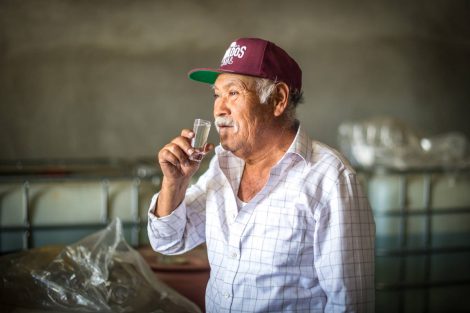
Alberto Beto, palanquero in Bramaderos in the pueblo of Miahuatlan de Porfirio Diaz
Alberto Beto and son Onofre Ortiz
Then there's Alberto Beto and his son Onofre Ortiz in Bramaderos de Porfirio Díaz, the fourth and fifth generations in mezcal production. Father and son perform excellent work in production with recipes that involve a variety of agave blends. The practice of "mezcla" (blending during production) is an ancient one, and Don Beto is one of the best in the business. "Much of the quality of our Mezcal comes from the uniqueness of the soil, characterized by the characteristic orange color of this region, which gives the spirit an extraordinary mineral strength," they explain. With a short 4x4 journey from the distillery, you reach a breathtaking plateau, a vast and infinite panorama framed by sky and agave.

Don Baltazar's facility in San Luis del Rio.
Don Baltazar
Next is Don Baltazar in San Luis Del Rio, a first-generation palenquero characterized by a strong and direct personality. He is a man of integrity who has built his mezcal reality with his two sons, who are now both owners of their own palenque. Baltazar is known for his entrepreneurial skills, not only for creating a successful business but also for offering himself as a consultant in other mezcal projects in different states. His daughters-in-law are actively involved in his palenque, distinguishing themselves for their competence in product management. It is a pleasure to see the extended family work together, especially during lunch breaks when they gather to share tacos and typical Sierra soup. "San Luis del Rio is a village where a considerable amount of Mezcal has been produced for over ten years. The region is renowned for its good soil, conducive to the cultivation of various agave varieties, including Espadín, Sierra negra, Tepextate, Mexicano, Coyote, and Mexicanito," they proudly state.

The fermentation tanks at Don Valente Garcia's distillery in Santa Maria La Pila.
Don Valente Garcia
A visit to Don Valente Garcia in Santa Maria La Pila is also worthwhile—a fourth-generation palenquero in Mezcal production. A great distiller, he brought back his sons who had emigrated to the United States, convincing them to work with him in the distillery after several years of experience with the well-known Alipús brand. Don Valente is an example of how a farmer and master palenquero can transform his business into a successful family enterprise. He has currently passed the baton to the fifth and sixth generations of the family: Adrián, Raúl, and nephew Semeí are doing an excellent job, cultivating numerous agaves naturally and producing high-quality Mezcal.
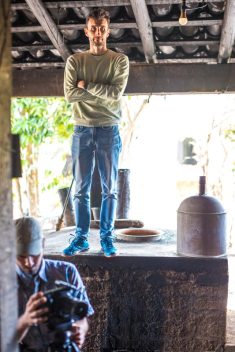
Eduardo Martinez, son of Gregorio, at the San Baltazar Guelavila facility.
Eduardo Martinez
Finally, you reach the palenque of Don Gregorio Martinez (recently deceased) in San Baltazar Guelavila. "He was a highly esteemed producer and Zapotec culture expert, whose most appreciated productions were those made with Cuishe and Madrecuishe agaves," remembers his son Eduardo. In 2002, he managed to fulfill his dream of having his own distillery, which has been quite successful over the years, now in the hands of his young heir. It will be beautiful to get to know and experience this place, still intact and frequented by Don Gregorio's almost centenarian father Juan, who continues to roam the fields with his faithful machete, and by the horse still used to turn the stone wheel with which the agave parts are crushed.

A sustainability project
"It is crucial to support projects that deal with producers according to traditions, promoting their entrepreneurial growth, organic agave cultivation, individual well-being, favorable working conditions, and, consequently, the quality of their products. The goal is to trace a detailed map of the terroir of Oaxaca, the diversity of agave species, and the natural conditions that give it a rich heritage of information during its long growth process. These producers operate following an artisanal approach, some introducing modern changes in various stages of production, always with attention to the quality of the land, agaves, and the production process, based on their personal recipe." The words of Velier's President Luca Gargano are undoubtedly a recipe for life.
Journeys are made of beauty, but above all, they are made of encounters. The producers and their families have contributed to making the discovery of the Oaxaca territory unique and exciting; reaching their homes is worth the journey and will show what is really behind every bottle of Mezcal that you come across in bars around the world. When you are with the palenqueros, don't forget, before each toast, to pour a few drops of Mezcal on the ground as an offering to the Mexican mother nature—stiigi beu (health in Zapotec)!


 Historical breakthrough: Italy will also produce dealcoholised wines. Lollobrigida signs the decree
Historical breakthrough: Italy will also produce dealcoholised wines. Lollobrigida signs the decree If you say Syrah, you say Cortona. The story of Stefano Amerighi and other Tuscan producers
If you say Syrah, you say Cortona. The story of Stefano Amerighi and other Tuscan producers The Game (and the misunderstanding) of dealcoholised wines: even an expert critic can be fooled at first sip
The Game (and the misunderstanding) of dealcoholised wines: even an expert critic can be fooled at first sip With fish, you can (also) drink red!
With fish, you can (also) drink red! The story of the pharmacist who dispenses prescriptions by day and crafts gourmet burgers by night
The story of the pharmacist who dispenses prescriptions by day and crafts gourmet burgers by night
